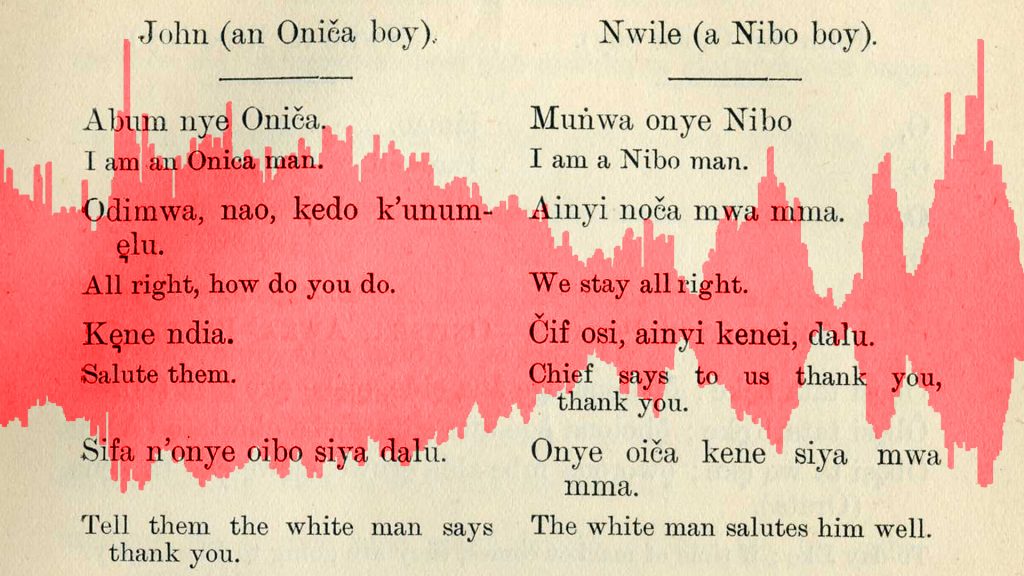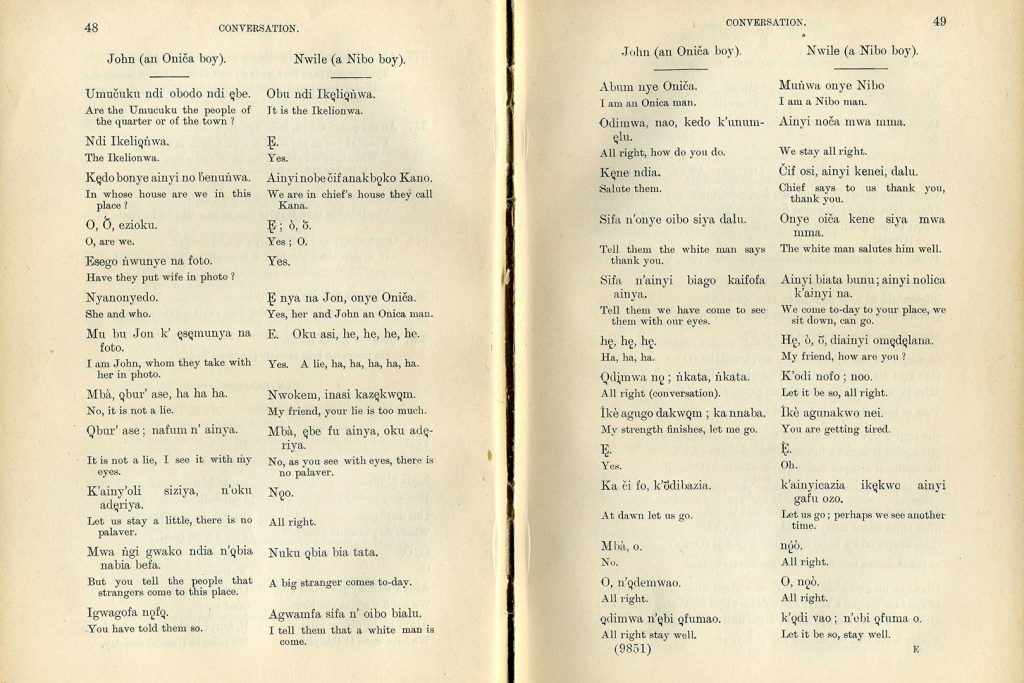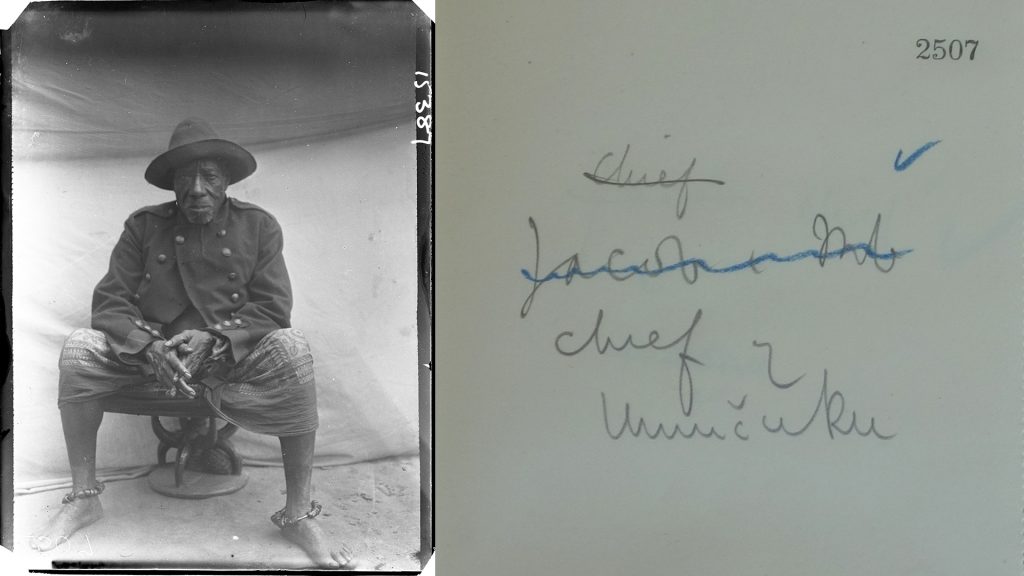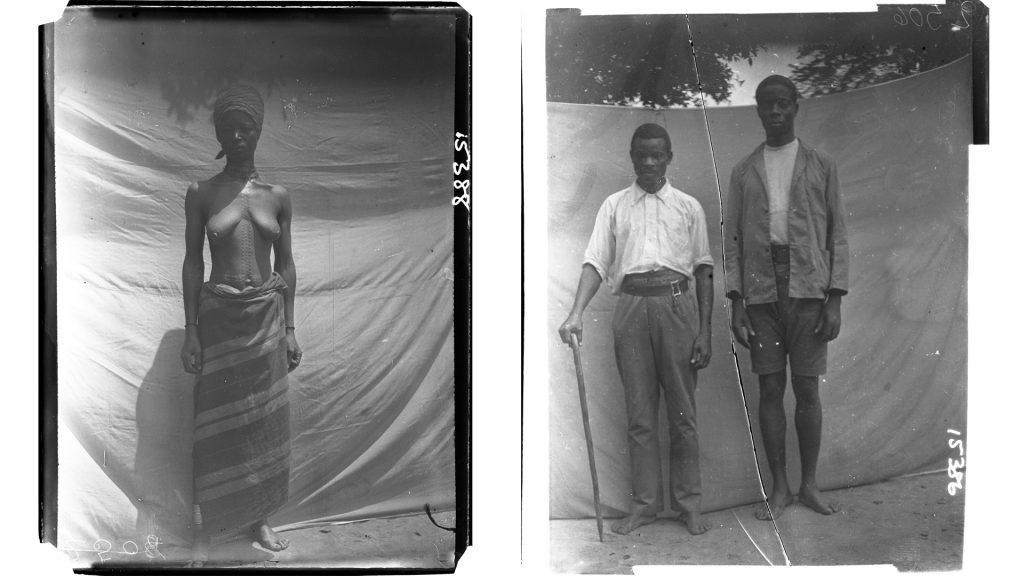
The phonograph sound recordings made during Northcote Thomas‘ anthropological surveys in Nigeria and Sierra Leone are like time capsules. Between 1909 and 1915, Thomas and his local assistants made well over 700 recordings of songs, stories and ‘specimens of language‘. Many of these have been unheard for over a century.
Thanks to digitization of the original wax cylinders by the British Library, these recordings are now accessible once again. As part of the [Re:]Entanglements project, we have been working with communities and local language/dialect speakers to transcribe and translate as many of the recordings as possible. It is not easy work, partly due to changes in the languages over 100 years and partly due to the poor quality of the wax cylinder recordings.
When we are able to obtain a good transcription and translation, the results are often quite startling. They provide remarkable insights into a moment in time: a moment of colonial intrusion, of which the anthropological survey was, of course, a part.
Recording No.465 was made during N. W. Thomas’s 1910-11 tour of what the colonial authorities had designated Awka District, in the Protectorate of Southern Nigeria, corresponding approximately to present-day Anambra State. The recording appears to have been made in the town of Umuchukwu, also known as Ndikelionwu, in 1911. It is a recording of a conversation between two young men, John, described as ‘an Onitsha boy’, and Nwile, ‘a Nibo boy’. Judging from the conversation, it seems that they have both accompanied the anthropologist on his visit to Umuchukwu, although Nwile seems to know the local chief and acts as an intermediary.
We worked with Yvonne Mbanefo and Oba Kosi Nwoba to obtain a transcription and English translation from the Igbo. With the translation in hand, we also discovered that Thomas had actually already published a transcription and translation of the recording in the third part of his Anthropological Report on the Ibo-Speaking Peoples of Nigeria, which is devoted to ‘Proverbs, Narratives, Vocabularies and Grammar’. Usually Thomas noted the record number alongside published transcriptions/translations, but on this occasion he neglected to do so. It was, however, easy to recognize the text once we received the translation. It is interesting to compare the original phonetic rendering and translation with the new one. (We discuss the orthographic conventions that Thomas employed in a previous blog post.)

The transcription and translation provided by Yvonne Mbanefo and Oba Kosi Nwoba:
| D’anyị, I noo mma? Ano m nnoo! Kedu ka ịmee? A nọ m nnoo ọfụma I budi onye ebe? Abụ m onye Nibo Oo! | Brother, are you well? I am just there How are you? I am just fine. Where are you from? I am from Nibo Oh! |
| Mu na gi na aluko olu na ofu ebe. Ọ maka no-ofu. Anyị nwa wee bia n’obodo ndị a. Anyị bialu ụmụchukwu tata. | We work together in the same place It is a good thing We came to this people’s town We came to Umuchukwu today. |
| Umuchukwu ndị a bụ ndị ebe? Fa bụ ndị ikeri-ọnwụ Ndị Ikeri-ọnwụ? Eh! | This Umuchukwu is in which part? It is in Ikeri-onwu. Ikeri-onwu? Yes! |
| Kedukwa onye anyị no be ya? Anyi no be Chief a na-akpọ Kanu. O! Ya na ndị be ya niile. Esego nwunye ya na foto? Esego nwunye ya tata Ya na onye du? Ya na nke onye Ọnicha Ezi e? Eh! | Who are we even in his house? We are in Chief Kanu’s house Oh! With his whole family Have they taken photograph of his wife? The wife was photographed today With who? She and the person from Onitsha Truthfully? Yes. |
| Mụnwa bụ John ka eselu mu na ya na foto tata. Ọ ya ka m fukwalu. Okwu asị! Mba, afulu m ya, hahaha! D’anyị amuna amu n’ofu! I na-asika asi nwoke m. Nwoke m, ọ bụghị asi, afulu m n’anya. Ọ di mma ebe Ị fulu n’anya na okwu adiro ya. Ka anyị norisizia nu. Ma gị gwakwa ndị a na abiama bialu be fa. Nnukwu ife bialu tata. | It is I John, that was photographed with her today. That is what I have seen. It is a lie! No, I saw it, haha! Brother don’t laugh like that You are always lying, my man My man, it is not a lie, I saw it. It is ok since you saw it, there is no disputing it. Let us relax. But tell them that they have a visitor. A big thing came today |
| Ị gwago fa na ọ bụ ndị-oyibo Agwalu m fa, si fa na ndị-oyibo bịalụ Ka fa kwadobe ndi be fa niile. Abụ m onye Ọnicha Nnọọ! Gị nwa onye Nibo. Unu apụtachago ụla? Ọ dị mma. Nnọọ o! Kedu ka unu melu? Anyị nocha mma mma. | Have you told them it is the white people? I told them that the white people are here, let them prepare their people. I am from Onitsha. Welcome! You, from Nibo. It is well. Welcome! How are you people doing? We are all fine. |
| Kene ndị a daalụ o! Chief achoo Ị kene gị, gị daalụ o! Si fa na onye-ocha si fa daalu o! Onye-ọcha kenelu gị mma mma o! | Greet this people! Chief, he wants to greet you, greetings to you! Tell them that the white person greets them. The white person greets you well. |
| Si fa n’anyi bialu k’anyi fu fa anya o! Anyi bịalụ nkata bunu K’anyi wee nolisia o! K’anyi nọlisịa olịlị k’anyị naa o! Hahahaha! Ọmelụ agaa du? Mma mma ka ọ dị. Ọ dị mma o, Nkata nkata ka ọ bụ. Ka ọ dị n’ofu. Nnọọ o! Ike agwubago m, ka m naa. Eh? Eh! Ọ dị mma, kachifo! Ka ọ dịbazịa! K’anyị nolikwa, ikekwe anyị ga-afu ọzọ. Nodu nma o! Nnọọ o! Ka ọ diba! Ọ dị mma, na-eme ofuma. | Tell them we came to see them. We came to have a chat in your house. Let us stay well! When we are done enjoying our visit, let us go! Haha! How are things? Everything is fine. It is well, they are all conversations. Let it be like that. Welcome! I am getting tired, let me go. Ok? Ok. It is well, goodnight, later! Let’s be seeing, we will probably see again. Stay well! Later! It is well, be good. |
The conversation would, of course, have been staged for the phonograph recorder, perhaps to document the differences in Onitsha and Nibo dialects. But, while the primary purpose of the recording was linguistic, through their exchange, John and Nwile also tell us a great deal about the broader encounter between the anthropologist, the Umuchukwu elite and their own joking relationship. The latter is most evident when listening to the men laughing together.
From this audio recording, we can build up a picture of the visit of the oyibo – the whiteman – to Chief Kanu’s compound in Umuchukwu. This entails multiple linguistic mediations between N. W. Thomas and John, John and Nwile, and Nwile and Chief Kanu. We gain insight into the formal greetings exchanged and the communication that the anthropologist has come to see the chief and to talk. We learn that the chief’s wife has been photographed that day, apparently alongside John himself! (The word ‘foto‘ has clearly entered the Igbo vocabulary by this time.)

Unfortunately, the annotations accompanying the photographs that Thomas made in Umuchukwu are vague and confusing, with crossings out and omissions. The ‘Chief of Umuchukwu’ is, however, identified (though the name ‘Chief Jacob Mbonu’ is crossed out) – is this Chief Kanu? The next photograph in the sequence is of a woman with mbubu scarification marks running down her chest and stomach. Is this one of chief’s wives? (There is no sign of John besides her!) And then there is another photograph of two men dressed in European clothing. They are dressed in a similar manner to Thomas’ assistants and translators elsewhere. Might they just be John and Nwile?

Northcote Thomas’s phonograph recordings constitute an important and untapped historical resource. While they were recorded largely for linguistic research purposes, today they provide a unique opportunity for us to hear the voices of those normally assumed to be silenced in the colonial archive. The Indian postcolonial studies scholar Gayatri Chakravorty Spivak famously asked ‘Can the Subaltern Speak?’ – listening carefully to the colonial anthropologists’ wax cylinder recordings we are in no doubt that they can indeed, and that their voices provide a crucial counter-narrative to dominant historical accounts.
Thank you to Yvonne Mbanefo, Oba Kosi Nwoba and the British Library. If you are an Igbo speaker, do please let us know if you spot any errors in the transcription or translation of the conversation between John and Nwile, or have any alternative interpretations! Please leave a comment here or email us at [email protected].